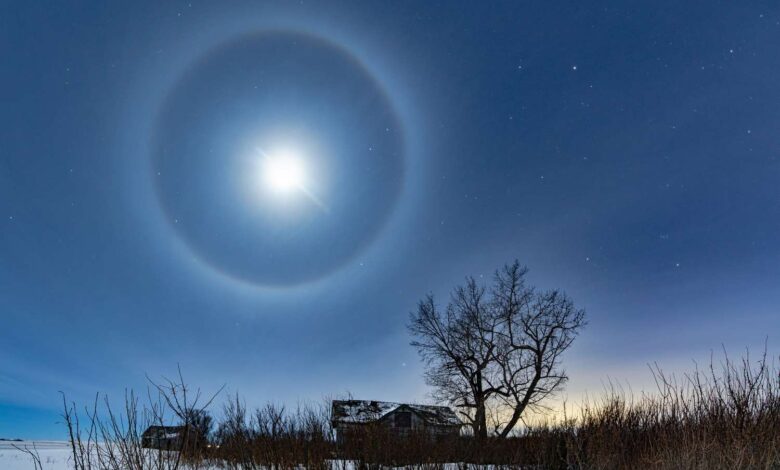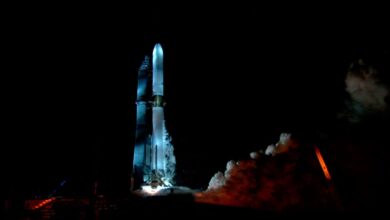What Causes a Ring to Appear Around the Moon?

:max_bytes(150000):strip_icc():format(jpeg)/GettyImages-1331563999-22ca27ce7da14f59a1434444d71575c9.jpg)
Although many lunar phenomena are one-night-only events, a ring around the moon is much less elusive. Also known as a lunar halo, a bright white ring of light around the moon can appear anytime during the lunar calendar and at any time of year, especially in winter.
But, if you hope to see a lunar halo, you’ll want to disregard the number one rule of stargazing which says you shouldn’t stargaze in cloudy weather. Lunar halos are caused by thin, wispy, cirrus and cirrostratus clouds and refraction and reflection of moonlight by the clouds’ ice crystals.
Below, we explore the lunar spectacle of a ring around the moon and tell you how to find the best viewing conditions.
Ideal Sky Conditions for Ring Formation
Like rainbows, lunar halos form when light interacts with water suspended in mid-air. That water is found frozen in cirrus and cirrostratus clouds—veil-like clouds that float 20,000 plus feet (6 km) above our heads where temperatures are too gelid to remain liquid water.
Tim Grist Photography / Getty Images
To best view a lunar halo, sky conditions must be clear with only a thin layer of cirrus clouds. If thicker clouds are present at lower levels, they’ll obscure the halo effect.
As moonlight shines through the cirrus clouds, it strikes the cloud’s millions of tiny ice crystals and refracts, or bends and changes direction, as it enters each. The light then refracts again as it exits a crystal’s other side.
How much the moonlight bends depends on the size and shape of the crystal. In the case of lunar halos, the ice crystals are tiny pencil-shaped (hexagonal) columns measuring less than 20 microns across. And they all bend light at a 22-degree angle from its original path (if you’ve ever heard lunar halos referred to as “22-degree halos,” this is why).
The moon’s light dispersed in all directions (above, below, beside, and diagonal) creates the lunar halo’s characteristic circular shape.
Did You Know?
According to weather lore, a ring around the sun or moon means rain or snow is coming soon. This superstition isn’t far wrong, since cirrus and cirrostratus clouds are often the first sign of an approaching warm front. So whenever you spot a halo, chances are you can expect rain or snow within 24 hours.
How and Why We See a Ring
Of course, to see the halo, the crystals must be oriented and positioned in a specific way to your eye. The light reflected off the ice crystals and that coming directly from the moon should intersect at your eye at angles of 22 degrees.
That’s why, like rainbows, halos around the moon (or sun) are personal. Every observer sees their particular halo made by their orientation to ice crystals. The sight of the ring around the moon varies from person to person depending on personal height, the elevation at the spot where you stand, and other factors.
A lunar halo’s colors tend to be dim because the sun is 400,000 times brighter than a full moon. They are so dim that the light is often too weak to be picked up by the color-detecting cells in our eyes, which is why lunar rings often appear milky white—white being the combination of all of light’s visible colors.
As for the sky between the ring and the moon, it usually remains dark because none of the ice crystals reflect light at smaller angles than 22 degrees.
The ring will remain visible as long as cirrus clouds create a veil across the moon.
Any Relation to Rings Around the Sun?
A halo will form around the sun when this same process occurs during daytime hours. Unlike rings around the moon, solar halos exhibit more of a red hue inside their ring and blue outside it.
Lunar Halo Look-Alikes
Brigitte Blättler / Getty Images
Lunar halos aren’t the only rings you’ll find encircling the moon. Halos are often confused with lunar coronas, but the latter are rainbow-colored discs that form when moonlight (or sunlight) interacts with water droplets in fog. Coronas also tend to circle tighter around the moon, creating a 10-degree rather than 22-degree radius.
Fogbows are white rings, similar to lunar halos, forming low to the ground. They, too, are comprised of water droplets—namely those tiny in size such as in a fine fog or mist.
During the winter of 2020, people saw the ring of all rings over Manitoba, Canada. Not only was the moon wreathed in white light, but corona, moon dogs, and tangent arcs occurred alongside the halo. Now, that’s a sight that beats a macabre blood moon any day or night.




